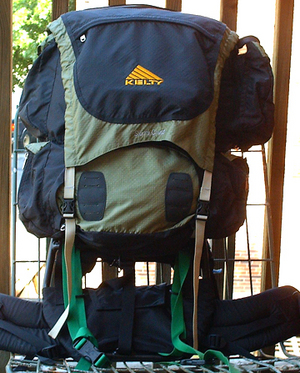How important is choosing a backpack for your wilderness adventure? It will make a difference in where you are able to go and how easy you get there. It will determine what kind, and how much gear you can carry.
A backpack will serve as your luggage in the wilderness. Take your time and pick one that will serve you for many trips. I recently retired a Kelty external frame pack after nearly twenty-five years of woods, airports and buses. The green external frame pack pictured in this article is the new one, still a Kelty. It has been on three Colorado excursions and many Missouri trips. Maryês pack, the black internal frame, has traveled to Colorado four times and been lugged across Missouri.
Most hikers choose between two types of backpack, internal or external frame. All packs have some things in common. It is the differences where making the right decision is crucial.
Internal and external packs both carry the varied gear a backpacker needs. Think about how many days you would average on the trail. Each pack is rated in cubic inches for how much space is available inside the main compartment and additional pockets. Check the manufacturer tag for the size and for how many days worth of stuff they recommend it can hold. The majority of modern backpacks have a waterproof sleeve inside to hold a water bladder with a convenient hole for the drinking hose to go through. Of course, they both have shoulder straps and padded hip belts. Most have a load lifter strap at the top for lifting a loaded pack without using the shoulder straps. External and internal packs diverge after considering the basics.
Internal frame backpacks have become the industry standard. For airline travel they can not be equaled. The frame is composed of aluminum stays that are sewn in. These can sometimes be carefully bent to fit closer to the back of the wearer. The formfitting profile reduces the chance of snagging against rocks or branches and makes them ideal for climbing mountains or bushwhacking through undergrowth. These bags are packed with more weight at the bottom giving the wearer a lower center of gravity, making them the preferred choice for women. A comfortable fit can be achieved by adjusting the torso length and harness. Thick back padding made from synthetic material wicks moisture away allowing it to dry quickly. Loops and daisy chains are added to hang small items on the outside. A top lid provides a small pocket that on some models can be removed and used as a hip bag.
An internal frame pack does have limitations. It is a straight bag that is filled from bottom to top, one item atop another. This can make it difficult to arrange gear conveniently. Attaching too many objects outside of the bag can cause it to wobble when hiking. They do not have the support necessary for carrying heavy loads.
External frame backpacks are uncommon on store shelves. Less expensive then internal frames they could be your best choice. They are meant to carry heavy loads over wide trails. The bag is attached to an aluminum frame with space to attach large gear on the outside. Heavier weight is carried high, supported by the shoulders and padded hip belt. There are multiple adjustments for the shoulder straps, torso length, where the bag rests on the frame, and how far out from the lower back it rides. This enables the wearer to carry more weight with greater comfort. Multiple exterior pockets allow quick access to smaller items, or gear that may be needed on the trail. Tent and sleeping mat can be strapped to the exposed aluminum frame above or below the main bag.
An external frame pack is a cumbersome looking box. Center of gravity is high due to the weight distribution so it is not recommended for boulder hopping. The frame and outside pockets do get hung up on branches when the trail gets narrow.
Each pack has good points, and bad. They have different uses. I personally prefer the external frame, but I have experienced the value of an internal. On our trips we have both. The bear canister, tent poles, closed cell mattresses, stove and fuel are packed in the external frame. In the outside pockets are maps, compass, insect repellent, flashlight, whistle, extra film and ponchos in case we need them quickly. Clothing, tent, sleeping bags, food, and a few luxuries are in the internal. It is an effective division of space and labor.
Good outdoor supply stores will allow you to try backpacks on. Load them up, adjust the straps, and walk around with them. Take your time. You can not change your mind once you are on the trail.





